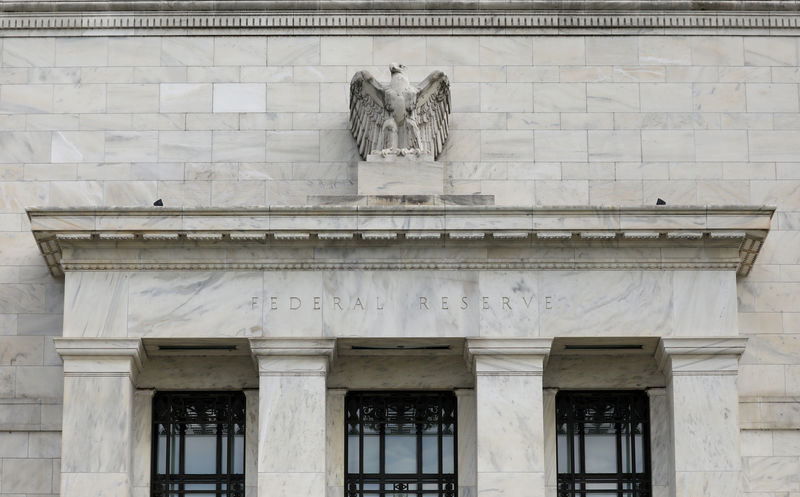 © Reuters. FILE PHOTO: The Federal Reserve building is pictured in Washington
© Reuters. FILE PHOTO: The Federal Reserve building is pictured in WashingtonBy Jamie McGeever
LONDON (Reuters) – The Federal Reserve will raise interest rates later this week and probably again early next year, but that will be the end of tightening cycle and it won’t be long before rate cuts are on the table.
That’s the message being sent out by the latest twists to hedge fund positioning at the short end of the U.S. Treasury curve: speculators now hold a record short position in two-year futures, while bullish momentum in five-year bonds is the strongest in over a decade.
(For a graphic on ‘CFTC 2y positions’ click https://tmsnrt.rs/2S8gVjO)
(For a graphic on ‘CFTC 5y position changes – momentum’ click https://tmsnrt.rs/2S48GVR)
The five-year yield fell below the two-year yield earlier this month for the first time since mid-2007, an inversion at the short end that many analysts reckon will be replicated in the more closely watched 2s/10s part of the curve soon enough.
The Fed is expected to raise rates for the ninth time this cycle on Wednesday, although money market traders aren’t as sure as they were a few weeks ago, ascribing only a 73 percent probability to an increase.
One more hike next year is no longer fully discounted by money markets, as the economic cycle comes closer to rolling over. But the Fed itself still reckons three might be warranted, and the consensus view of economists in a Reuters poll last week was that the Fed would raise twice next year.
President Donald Trump has publicly slated Fed chairman Jerome Powell for continuing to raise rates, branding the central bank under his guidance “loco”, “crazy” and “ridiculous”. A rate hike on Wednesday would be “foolish”, Trump told Reuters last week.
But there’s a school of thought that the more Trump leans on the Fed, the more Powell and his colleagues will resist, making further tightening in the near term far more likely than not. As long as the economic data warrant it, of course.
The overall picture is still one of reasonably steady if unspectacular growth, although some of the incoming numbers are starting to look a little patchy. The probability of recession in the next two years is now up to 40 percent, according to the latest Reuters poll of economists.
Liquidity concerns in certain corners of the financial market universe, such as high-yield credit, are starting to percolate to the surface too, suggesting the Fed may not be able to tighten much at all from here.
But as a tough year for hedge funds draws to a close, they are doubling down on bets that further Fed action will invert the short end of the yield curve.
Funds increased their net short two-year Treasury futures position by 55,677 contracts to a record -417,237 contracts in the week to Dec. 11. They also cut their net short position in five-year bonds by 61,848 contracts to -286,093 contracts.
The shift in the five-year space is significant. Specs have slashed their net short position by some 540,000 contracts in the fourth quarter so far, meaning the quarter will comfortably mark the heaviest quarter of buying since CFTC data began in 1995.
(For a graphic on ‘CFTC 5y Treasuries – quarterly change’ click https://tmsnrt.rs/2S3l9co)
(For a graphic on ‘U.S. Yield curve – 2s/5s’ click https://tmsnrt.rs/2QWlSPo)
The weekly bullish momentum generated in that period is the strongest since April-May 2008, just after Bear Stearns collapsed and a few months before Lehman would implode. Hedge funds haven’t been net long of five-year futures since March 2015.
The 2s/5s inversion has been shallow, at no more than 3 basis points, but that part of the curve has clearly inverted. The 2s/10s curve, meanwhile, came within 10 basis points of recession-warning inversion earlier this month.
The common thread is the relatively high two-year yield, reinforcing the old market maxim that cash is king. This year will be the first year since 1994 where three-month Treasury bills outperform both the and the U.S. 10-year bond, according to Charlie Bilello at Pension Partners in New York.
In sum, cash and the two-year part of the curve suggest the Fed is near the end of its tightening cycle, just not quite yet, while the five-year part of the curve indicates rate cuts may not be too far away.
(The opinions expressed here are those of the author, a columnist for Reuters)
(By Jamie McGeever, editing by Larry King)
Source: Investing.com



























